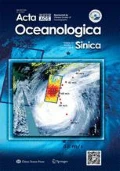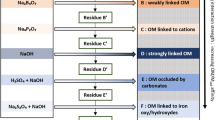Abstract
Organic and inorganic carbon contents of marine sediments are important to reconstruct marine productivity, global carbon cycle, and climate change. A proper method to separate and determine organic and inorganic carbons is thus of great necessity. Although the best method is still disputable, the acid leaching method is widely used in many laboratories because of its ease-of-use and high accuracy. The results of the elemental analysis of sediment trap samples reveal that organic and inorganic carbon contents cannot be obtained using the acid leaching method, causing an infinitely amplified error when the carbon content of the decarbonated sample is 12%±1% according to a mathematical derivation. Acid fumigation and gasometric methods are used for comparison, which indicates that other methods can avoid this problem in organic carbon analysis. For the first time, this study uncovers the pitfalls of the acid leaching method, which limits the implication in practical laboratory measurement, and recommends alternative solutions of organic/inorganic carbon determination in marine sediments.
Similar content being viewed by others
References
Bai Yazhi, Liu Jihua, Zhang Hui, et al. 2013. The analysis of organic carbon and total nitrogen in marine sediments. Marine Environmental Science (in Chinese), 32(3): 444–447, 459
Bisutti I, Hilke I, Raessler M. 2004. Determination of total organic carbon-An overview of current methods. TrAC Trends in Analytical Chemistry, 23(10-11): 716–726
Black H D, Anderson W T, Alvarez Zarikian C A. 2018. Data report: organic matter, carbonate, and stable isotope stratigraphy from IODP Expedition 346 Sites U1426, U1427, and U1429. In: Tada R, Murray R W, Alvarez Zarikian C A, et al., eds. Proceedings of the Integrated Ocean Drilling Program, Volume 346. College Station, TX: Integrated Ocean Drilling Program, 2–3
Blattmann T M, Zhang Yanwei, Zhao Yulong, et al. 2018. Contrasting fates of petrogenic and biospheric carbon in the South China Sea. Geophysical Research Letters, 45(17): 9077–9086, doi: https://doi.org/10.1029/2018GL079222
Brodie C R, Leng M J, Casford J S L, et al. 2011. Evidence for bias in C and N concentrations and ´13C composition of terrestrial and aquatic organic materials due to pre-analysis acid preparation methods. Chemical Geology, 282(3–4): 67–83
Byers S C, Mills E L, Stewart P L. 1978. A comparison of methods of determining organic carbon in marine sediments, with suggestions for a standard method. Hydrobiologia, 58(1): 43–47, doi: https://doi.org/10.1007/BF00018894
Castro C G, Chavez F P, Pennington J T, et al. 2018. Temporal variability of downward fluxes of organic carbon off Monterey Bay. Deep Sea Research Part II: Topical Studies in Oceanography, 151: 89–101, doi: https://doi.org/10.1016/j.dsr2.2018.07.001
Chen Jianfang, Wiesner M G, Li Hongliang, et al. 2015. Biogeochemical fluxes and biological pump composition in the South China Sea. Bulletin of Mineralogy, Petrology & Geochemistry (in Chinese), 34(5): 911–919
Chen Jianfang, Zheng Lianfu, Chen Ronghua, et al. 1998. Fluxes and constituents of particulate matter in the South China Sea in comparison with sediment accumulation rates. Acta Sedimentologica Sinica (in Chinese), 16(3): 14–19
Cheng Sihai, Lei Zhisheng, Chen Daohua. 2010. Determination of carbonate in marine sediment by element analyzer. Chemical Analysis & Meterage (in Chinese), 19(5): 29–31
Froelich P N. 1980. Analysis of organic carbon in marine sediments. Limnology & Oceanography, 25(3): 564–572
Galy V, Bouchez J, France-Lanord C. 2007. Determination of total organic carbon content and δ13C in carbonate-rich detrital sediments. Geostandards and Geoanalytical Research, 31(3): 199–207, doi: https://doi.org/10.1111/j.1751-908X.2007.00864.x
Gibbs R J. 1977. Effect of combustion temperature and time, and of the oxidation agent used in organic carbon and nitrogen analyses of sediments and dissolved organic material. Journal of Sedimentary Research, 47(2): 547–550
Harris D, Horwáth W R, Van Kessel C. 2001. Acid fumigation of soils to remove carbonates prior to total organic carbon or carbon-13 isotopic analysis. Soil Science Society of America Journal, 65(6): 1853–1856, doi: https://doi.org/10.2136/sssaj2001.1853
Hedges J I, Stern J H. 1984. Carbon and nitrogen determinations of carbonate-containing solids. Limnology and Oceanography, 29(3): 657–663, doi: https://doi.org/10.4319/lo.1984.29.3.0657
Jones G A, Kaiteris P. 1983. A vacuum-gasometric technique for rapid and precise analysis of calcium carbonate in sediments and soils. Journal of Sedimentary Research, 53(2): 655–660, doi: https://doi.org/10.1306/212F825B-2B24-11D7-8648000102C1865D
Keil R. 2017. Anthropogenic forcing of carbonate and organic carbon preservation in marine sediments. Annual Review of Marine Science, 9(1): 151–172, doi: https://doi.org/10.1146/annurev-marine-010816-060724
King P, Kennedy H, Newton P P, et al. 1998. Analysis of total and organic carbon and total nitrogen in settling oceanic particles and a marine sediment: an interlaboratory comparison. Marine Chemistry, 60(3–4): 203–216
Komada T, Anderson M R, Dorfmeier C L. 2008. Carbonate removal from coastal sediments for the determination of organic carbon and its isotopic signatures, δ13C and Δ14C: comparison of fumigation and direct acidification by hydrochloric acid. Limnology and Oceanography: Methods, 6(6): 254–262, doi: https://doi.org/10.4319/lom.2008.6.254
Li Liangge, Xu Jinshu. 1987. A comparison of major methods of determination of organic carbon in marine sediments. Tropic Oceanology (in Chinese), 6(1): 46–51
Li Jiabiao, Ke Changzhi, Kang Shouling, et al. 2008. GB/T 12763.8-2007 Specifications for oceanographic survey—Part 8: Marine geology and geophysics survey (in Chinese). Beijing: Standards Press of China, 22–28
Lorrain A, Savoye N, Chauvaud L, et al. 2003. Decarbonation and preservation method for the analysis of organic C and N contents and stable isotope ratios of low-carbonated suspended particulate material. Analytica Chimica Acta, 491(2): 125–133, doi: https://doi.org/10.1016/S0003-2670(03)00815-8
Nelson D W, Sommers L E. 1982. Total carbon, organic carbon, and organic matter. In: Sparks D L, Page A L, Helmke P A, et al., eds. Methods of Soil Analysis. Madison: Agronomy Society of America and Soil Science Society of America, 539–579
Passow U, Carlson C A. 2012. The biological pump in a high CO2 world. Marine Ecology Progress Series, 470: 249–271, doi: https://doi.org/10.3354/meps09985
Peng Yajun, Wang Yujue, Liu Dongyan, et al. 2015. Acid treatment effects on the carbon stable isotope values of marine sediments. Haiyang Xuebao (in Chinese), 37(12): 85–92
Qiu Lingjia, Huang Guolin, Su Yu, et al. 2015. An overview on current measurment methods of total organic carbon. Guangdong Chemical Industry (in Chinese), 42(9): 107–108, 96
Roberts A A, Palacas J G, Frost I C. 1973. Determination of organic carbon in modern carbonate sediments. Journal of Sedimentary Petrology, 43(4): 1157–1159
Ryba S A, Burgess R M. 2002. Effects of sample preparation on the measurement of organic carbon, hydrogen, nitrogen, sulfur, and oxygen concentrations in marine sediments. Chemosphere, 48(1): 139–147, doi: https://doi.org/10.1016/S0045-6535(02)00027-9
Schubert C J, Nielsen B. 2000. Effects of decarbonation treatments on δ13C values in marine sediments. Marine Chemistry, 72(1): 55–59, doi: https://doi.org/10.1016/S0304-4203(00)00066-9
Schwartz V. 1995. Fractionated combustion analysis of carbon in forest soils—New possibilities for the analysis and characterization of different soils. Fresenius’ Journal of Analytical Chemistry, 351(7): 629–631, doi: https://doi.org/10.1007/BF00323339
Sun Xuan, Song Jinming, Yu Ying, et al. 2014. A rapid method for determing the total organic carbon and total nitrogen in marine sediments with an elemental analyzer. Marine Sciences (in Chinese), 38(7): 14–19
Tan Yang, Wu Xueli, Hou Lijie. 2018. The effects of sample treatment methods on marine sediment organic carbon stable isotope. Marine Environmental Science (in Chinese), 37(5): 780–784
Tripathi S, Tiwari M, Lee J, et al. 2017. First evidence of denitrification vis-à-vis monsoon in the Arabian Sea since Late Miocene. Scientific Reports, 7(1): 43056, doi: https://doi.org/10.1038/srep43056
Verardo D J, Froelich P N, McIntyre A. 1990. Determination of organic carbon and nitrogen in marine sediments using the Carlo Erba NA-1500 Analyzer. Deep Sea Research Part A. Oceanographic Research Papers, 37(1): 157–165, doi: https://doi.org/10.1016/0198-0149(90)90034-S
Walkley A, Black I A. 1934. An examination of the Degtjareff method for determining soil organic matter, and a proposed modification of the chromic acid titration method. Soil Science, 37(1): 29–38, doi: https://doi.org/10.1097/00010694-193401000-00003
Wang Yifan, Huang Depei, Cui Shuying. 1988. Determination of total carbon, organic carbon and inorganic carbon in marine sediments by 240C elemental analyzer. Marine Environmental Science (in Chinese), 7(2): 73–77
Weliky K, Suess E, Ungerer C A, et al. 1983. Problems with accurate carbon measurements in marine sediments and particulate matter in seawater: A new approach. Limnology and Oceanography, 28(6): 1252–1259, doi: https://doi.org/10.4319/lo.1983.28.6.1252
Wu Jinping, Calvert S E, Wong C S, et al. 1999. Carbon and nitrogen isotopic composition of sedimenting particulate material at Station Papa in the subarctic northeast Pacific. Deep Sea Research Part II: Topical Studies in Oceanography, 46(11–12): 2793–2832
Yang Shouye, Li Congxian. 2006. Compositions of organic elements and carbonate in the late Cenozoic sediments of the Changjiang Delta: Implication for paleoenvironmental changes. Geochimica (in Chinese), 35(3): 249–256
Zhang Weiyan, Jin Haiyan, Zhang Fuyuan, et al. 2009. Organic carbon distribution in the Yangtze River estuary-Hangzhou Bay and its adjacent sea area. Advances in Earth Science (in Chinese), 24(11): 1202–1209
Acknowledgements
We acknowledge the helpful suggestions provided by Martin G. Wiesner of Universität Hamburg, Germany. We also thank Pengfei Ma, Shaohua Zhao, Xiaodong Zhang, Kui Duan, and Baozhi Lin from Tongji University for their participation in the cruise or experimental analysis.
Author information
Authors and Affiliations
Corresponding author
Additional information
Foundation item: The National Natural Science Foundation of China under contract Nos 41530964, 41776047, 41876048 and 91528304.
Rights and permissions
About this article
Cite this article
Ling, C., Liu, Z., Zhang, J. et al. Pitfalls of acid leaching method for determining organic and inorganic carbon contents in marine sediments. Acta Oceanol. Sin. 39, 96–102 (2020). https://doi.org/10.1007/s13131-020-1631-z
Received:
Accepted:
Published:
Issue Date:
DOI: https://doi.org/10.1007/s13131-020-1631-z



